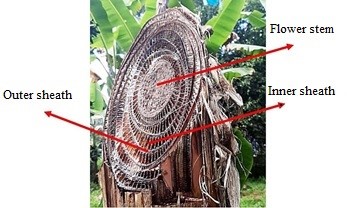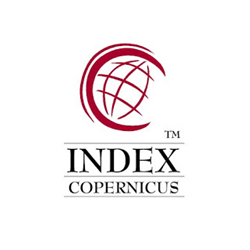Physical-mechanical properties of Musa acuminata particles composites
DOI:
https://doi.org/10.17981/ingecuc.18.1.2022.18Keywords:
Particles composites, Mechanical properties, Water absorption, Thermography, Musa acuminateAbstract
Introduction: Currently, the development of materials from renewable resources is growing worldwide; non-wood lignocellulosic fibers from different plant species or agro-industrial residues are an interesting source of raw material.
Objective: The objective of this work is the development and physical-mechanical characterization of a composite material based on Musa acuminata pseudostem particles and a thermosetting resin.
Method: The composite was prepared with particles of an average size of 450 µm, washed with a NaOH solution and oven-dried at 70°C for 24 h. The moisture content was controlled. In manufacturing, the particles were glued with urea formaldehyde resin in a drum-type mixer and pressed in thermal plates at 160°C and 107 psi. The composites were analyzed mechanically, obtaining data on modulus of rupture, elastic modulus and tensile strength. Penetration hardness and water absorption resistance tests were also performed. Moreover, thermographic tests were performed on the surface of the material. The results were compared with those obtained in commercial composites.
Results: It was observed that the Musa acuminata composite presented greater resistance to moisture absorption, higher elastic modulus and was more resistant to tensile stresses. Additionally, the commercial composite showed lower penetration resistance. The Musa acuminata composite achieved higher thermal insulation in thermographic tests.
Conclusions: Musa acuminata is a species with a high agro-industrial flow and a considerable producer of residues, which has interesting viable physical-mechanical characteristics to produce particle agglomerates that meet engineering standards.
Downloads
References
M. Ramesh, K. Palanikumar, K. H. Reddy, “Plant fibre based bio-composites: Sustainable and renewable green materials” Renewable and Sustainable Energy Reviews, Vol. 79, pp. 558-584, Nov. 2017. https://doi.org/10.1016/j.rser.2017.05.094
S. K. Ramamoorthy, M. Skrifvars, A. Persson, “A Review of Natural Fibers Used in Biocomposites : Plant, Animal and Regenerated Cellulose Fibers” Polymer Reviews, Vol. 55, no. 1, pp. 107-162, Jan. 2015, https://doi.org/10.1080/15583724.2014.971124
M. Bilal, M. Asgher, H. M. N. Iqbal, H. Hu, X. Zhang, “Biotransformation of lignocellulosic materials into value-added products - A review” International Journal of Biological Macromolecules, Vol. 98, pp. 447–458, May. 2017, https://doi.org/10.1016/j.ijbiomac.2017.01.133
P. Fernandez, M. Freitas, M. Hilarrio, K. C. Coelho, A. Milanese, H. J. Cornelis, D. R. Mulinari, 2015. “Vegetal fibers in polymeric composites : a review” Polímeros, Vol. 25, no. 1, pp. 9-22, Jan. 2015, https://doi.org/10.1590/0104-1428.1722
M. George, M. Chae, D. C. Bressler, “Composite materials with bast fibres: Structural, technical, and environmental properties” Journal of Progress in Materials Science, Vol. 83, pp. 1-23, Oct. 2016, https://doi.org/10.1016/j.pmatsci.2016.04.002
A. Treviso, B. Van Genechten, D. Mundo. M. Tournour, “Damping in composite materials: Properties and models” Composites Part B, Vol. 78, pp. 144-152, Sep. 2015, https://doi.org/10.1016/j.compositesb.2015.03.081
M. Chanhoun, S. Padonou, E. Codjo, E. Olodo, V. Doko, 2018. “Study of the implementation of waste wood, plastics and polystyrenes for various applications in the building industry” Construction and Building Materials, Vol. 167, pp. 936-941, Abr. 2018, https://doi.org/10.1016/j.conbuildmat.2018.02.080
G. Ramachandra, M. Ashok, H. Ranganna, N. Karthikeyan, A. Ramesh, “Tamarind fruit Fiber (Tf) and Glass Fiber Reinforced Polyester Composites” Mechanics of Advanced Materials and Structures, Vol. 22, no. 9, pp. 37-41. Abr. 2015, https://doi.org/10.1080/15376494.2013.862330
E. Omrani, P. L. Menezes, P. K. Rohatgi, “State of the art on tribological behavior of polymer matrix composites reinforced with natural fibers in the green materials world” Engineering Science and Technology, an International Journal, Vol. 19, no. 2, pp. 717-736, 2016, https://doi.org/10.1016/j.jestch.2015.10.007
M. R. Sanjay, P. Madhu, M. Jawaid, P. Senthamaraikannan, S. Senthil, S. Pradeep, 2018 “Characterization and Properties of Natural Fiber Polymer Composites: A Comprehensive Review” Journal of Cleaner Production, Vol. 172, pp. 566-581, Jun. 2018, https://doi.org/10.1016/j.jclepro.2017.10.101
A. Chavez, L. A. Bello, E. Agama, F. J. Castellanos, “Isolation and partial characterization of starch from banana cultivars grown in Colombia” International Journal of Biological Macromolecules, Vol. 98, pp. 240-246, May. 2017, https://doi.org/10.1016/j.ijbiomac.2017.01.024
S. E. Guapacha, M. Salazar, J. Aguillón, C. P. Landázuri, “Similaridad cariotípica entre diversas variedades de Musa spp del Quindío-Colombia” Cultivos Tropicales, Vol. 38, no. 4, pp. 119-126, Oct. 2017
I. Cabeza, M. Thomas, A. Vásquez, P. Acevedo, “Anaerobic co-digestion of organic residues from different productive sectors in Colombia : Biomethanation potential assessment Anaerobic co-digestion of organic residues from different productive sectors in Colombia: biomethanation potential assessment” Chemical engineering transactions, Vol. 49, pp. 385-390, May. 2016, https://doi.org/10.3303/CET1649065
L. Pinheiro, L. Kohan, L. Oliveira, M. E. Eduardo-Garavello, J. Baruque‑Ramos, “Biomordants and new alternatives to the sustainable natural fiber dyeings” SN Applied Sciences, Vol. 1, no. 1356, Oct. 2019, https://doi.org/10.1007/s42452-019-1384-5
American Society for Testing and Materials – ASTM, “Standard Terminology Relating to Wood-Base Fiber and Particle Panel Materials” ASTM D1554-10, 2010.
L. Yan, N. Chouw, K. Jayaraman, “Effect of UV and water spraying on the mechanical properties of flax fabric reinforced polymer composites used for civil engineering applications,” Rev. Journal of Materials & Design, Vol. 71, pp. 17-25, 2015, https://doi.org/10.1016/j.matdes.2015.01.003
M. Pervaiz, S. Panthapulakkal, B. KC, M. Sain, J. Tjong, “Emerging trends in automotive lightweighting through novel composite materials,” Rev. Materials Sciences and Applications, Vol. 7, pp. 26-38, 2016, https://doi.org/10.4236/msa.2016.71004
O. Akampumuza, P. M. Wambua, A. Ahmed, W. Li, X. Qin, “Review of the applications of biocomposites in the automotive industry,” Rev. Polym Compos., Vol. 38, no. 11, pp. 2553-2569, 2017, https://doi.org/10.1002/pc.23847
A. Papadopoulos, “Banana chips (musa acuminata) as an alternative lignocellulosic raw material for particleboard manufacture” Maderas. Ciencia y tecnología, Vol. 20, no. 3, pp. 395 - 402, Jul. 2018, https://doi.org/10.4067/S0718-221X2018005031001
W. N. A. W. Nadharia, M. Danisha, M. S. R. M. Nasirb, B. J. Gengc, “Mechanical properties and dimensional stability of particleboard fabricated from steam pre-treated banana trunk waste particles” Journal of Building Engineering, Vol. 26, no. 100848, Nov. 2019, https://doi.org/10.1016/j.jobe.2019.100848
J. Wang, Y. Hu, “Novel particleboard composites made from coir fiber and waste banana stem fiber” Waste and Biomass Valorization, Vol. 7, pp.1447–1458, Mar. 2016, https://doi.org/10.1007/s12649-016-9523-3
A. A. Jimmim, T. A. Khan, A. Rahman, “Fabrication and characterization of low density particle boards from pseudo-stem of banana plant” AIP Conference Proceedings, Vol. 1980, no. 1, pp. 030031-1 - 030031-7, https://doi.org/10.1063/1.5044310
J. J. R. R. Aseer, K. Sankaranarayanasamy, P. Jayabalan, R. Natarajan, K. P. Dasan, #Morphological and mechanical properties of chemically treated municipal solid waste (MSW)/banana fiber and their reinforcement in polymer composites” Sci Eng Compos Mater, vol. 22, no. 4, pp. 353-363, Jul. 2015, https://doi.org/10.1515/secm-2013-0203
B. M. Ribeiro, L. Marin, G. H. Denzin, L. Bufalino, R. F. Mendes, J. B. Guimarães, “Chemical treatment of banana tree pseudostem particles aiming the production of particleboards” Ciência e Agrotecnologia, Vol.38 no.1, Jan. 2014, https://doi.org/10.1590/S1413-70542014000100005
J. C. Mejia, R. Rodriguez, J. J. Olaya, 2012 “The influence of alkali treatment on banana fibre’s mechanical properties” Ingeniería e investigación, Vol. 32, no. 1, pp. 83-87, Abr. 2012
American Society for Testing and Materials – ASTM, “Standard Test Method for Determining Formaldehyde Concentrations in Air from Wood Products Using a Small-Scale Chamber”, ASTM D6007-14, 2014.
Una Norma Española-Norma Europea “Wood Based Panels. Determination of Formaldehyde Content. Extraction Method Called the Perforator Method”, UNE-EN 120, 1994.
American Society for Testing and Materials – ASTM, “Standard Test Methods for Evaluating Properties of Wood-Base Fiber and Particle” ASTM D1037-12, 2012.
International Organization for Standardization “Non-destructive testing - Infrared thermography” ISO 10878, 2013
L. D. Benazco-Angel, 2015. “Preparación y caracterización de fibras naturales” Tesis Dep, Ingeniero Mec., Escuela Superior de Ingeniería y Tecnología., Universidad de la Laguna., Tenerife, España, 2015
L. Mott, L. Groom, S. Shaler, 2002. “Mechanical properties of individual southern pine fibers. part ll. comparison of earlywood and latewood fibers with respect to tree height and juvenility” Wood and Fiber Science, Vol. 34, no. 2, pp. 221-237, 2002
M. Boopalan, M. Niranjanaa, M. J. Umapathy, “Study on the mechanical properties and thermal properties of jute and banana fiber reinforced epoxy hybrid composites” Composites Part B, Vol. 51, pp. 54–57, Ago. 2013, https://doi.org/10.1016/j.compositesb.2013.02.033
A. Alavudeen, N. Rajini, S. Karthikeyan, M. Thiruchitrambalam, N. Venkateshwaren, 2014 “Mechanical properties of banana / kenaf fiber-reinforced hybrid polyester composites : Effect of woven fabric and random orientation” Journal of materials & design, V. 66, Part A, pp. 246-257, Feb. 2015, https://doi.org/10.1016/j.matdes.2014.10.067.

Downloads
Published
How to Cite
Issue
Section
License
Copyright (c) 2021 INGE CUC

This work is licensed under a Creative Commons Attribution-NonCommercial-NoDerivatives 4.0 International License.
Published papers are the exclusive responsibility of their authors and do not necessary reflect the opinions of the editorial committee.
INGE CUC Journal respects the moral rights of its authors, whom must cede the editorial committee the patrimonial rights of the published material. In turn, the authors inform that the current work is unpublished and has not been previously published.
All articles are licensed under a Creative Commons Attribution-NonCommercial-NoDerivatives 4.0 International License.


 English
English
 Español (España)
Español (España)






















